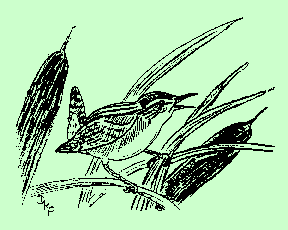|
The Long-Billed Marsh Wren

 "Enter almost any cattail marsh and you will be greeted by clicking notes
resembling the sound made by striking pebbles together. Watch and there will
appear a tiny, long-billed bird that clings to the rushes with rapidly
bobbing body, and tail drawn forward so far over its back that the end
almost touches the head. This is the long-billed marsh wren, whose name,
Telmatodytes palustris, is almost longer than the bird."
"Enter almost any cattail marsh and you will be greeted by clicking notes
resembling the sound made by striking pebbles together. Watch and there will
appear a tiny, long-billed bird that clings to the rushes with rapidly
bobbing body, and tail drawn forward so far over its back that the end
almost touches the head. This is the long-billed marsh wren, whose name,
Telmatodytes palustris, is almost longer than the bird."


 This wren of the marsh is brown, with a conspicuous white line over the eye,
light gray or whitish breast and throat, striped upper parts, and solid
unstreaked crown. The uplifted tail reveals whitish under coverts.
This wren of the marsh is brown, with a conspicuous white line over the eye,
light gray or whitish breast and throat, striped upper parts, and solid
unstreaked crown. The uplifted tail reveals whitish under coverts.

 Marsh wrens often group in colonies and sing in a chorus. In the Spring,
the males arrive about ten days ahead of the females, and each in his
chosen territory builds three or four dummy nests. It is thought that this
is done to frustrate intruders. When the females arrive, the male woos one
by perching above her, fluffing out his breast feathers, and cocking his
tail over his back, almost touching his head. The female builds the true
nest, a coconut shaped home of leaf strips, stems and grasses, lined with
down and fine fibers, with a small side entrance near the top. Usually it
is attached to several reed stems, one to three feet above the water. The
nests are constructed remarkably fast, with "unique architectural effects".
The number of brownish, spotted eggs varies from 3 to 10, usually 5 or 6.
They hatch in 13 to 16 days, and the first flight is taken when 11 to 16
days old. There may be two broods in a season. The males are often
polygamous. The diet almost entirely consists of the wide variety of
insects inhabiting the marsh. Often they are caught on the wing in the
manner of the flycatcher. The young are fed the softer bodied types. More
devoted homebodies are not to be found among the feathered tribe. They are
often spoken of as "Brownies of the Big Voices".
Marsh wrens often group in colonies and sing in a chorus. In the Spring,
the males arrive about ten days ahead of the females, and each in his
chosen territory builds three or four dummy nests. It is thought that this
is done to frustrate intruders. When the females arrive, the male woos one
by perching above her, fluffing out his breast feathers, and cocking his
tail over his back, almost touching his head. The female builds the true
nest, a coconut shaped home of leaf strips, stems and grasses, lined with
down and fine fibers, with a small side entrance near the top. Usually it
is attached to several reed stems, one to three feet above the water. The
nests are constructed remarkably fast, with "unique architectural effects".
The number of brownish, spotted eggs varies from 3 to 10, usually 5 or 6.
They hatch in 13 to 16 days, and the first flight is taken when 11 to 16
days old. There may be two broods in a season. The males are often
polygamous. The diet almost entirely consists of the wide variety of
insects inhabiting the marsh. Often they are caught on the wing in the
manner of the flycatcher. The young are fed the softer bodied types. More
devoted homebodies are not to be found among the feathered tribe. They are
often spoken of as "Brownies of the Big Voices".

 The long-billed marsh wren has an extensive breeding range, from across
southern Canada to Baja California, south central Mexico, the Gulf Coast,
and southern Florida. They seldom are found north of the Gulf States
between the Rockies and the Appalachians in the winter, and in reduced
numbers in the south elsewhere.
The long-billed marsh wren has an extensive breeding range, from across
southern Canada to Baja California, south central Mexico, the Gulf Coast,
and southern Florida. They seldom are found north of the Gulf States
between the Rockies and the Appalachians in the winter, and in reduced
numbers in the south elsewhere.

 You may hear their song, day or night -- a "continuum of throaty, gurgling
notes, a low bubbly trill, and a squeaky rattle".
You may hear their song, day or night -- a "continuum of throaty, gurgling
notes, a low bubbly trill, and a squeaky rattle".

 Recently this writer enjoyed watching and studying a pair of these wrens
at the Farmington Bay Bird Refuge. They made short hops above the water,
in among the cattails and reeds in an effort to keep themselves concealed
until they were far enough away to fly to a distance where they felt secure.
Recently this writer enjoyed watching and studying a pair of these wrens
at the Farmington Bay Bird Refuge. They made short hops above the water,
in among the cattails and reeds in an effort to keep themselves concealed
until they were far enough away to fly to a distance where they felt secure.

 -- by Marie L. Atkinson -- by Marie L. Atkinson
REFERENCES:
Field Guide to Western Birds
Roger Tory Peterson

Bird Neighbors
Neltje Blanchan

National Geographic
Winged Denizens of Woodland Streams & Marsh
Alexander Witmore

Birds of North America
A Golden Field Guide

The AUDUBON Illustrated Handbook of American Birds
Edgar M. Reilly, Jr.
|
|
